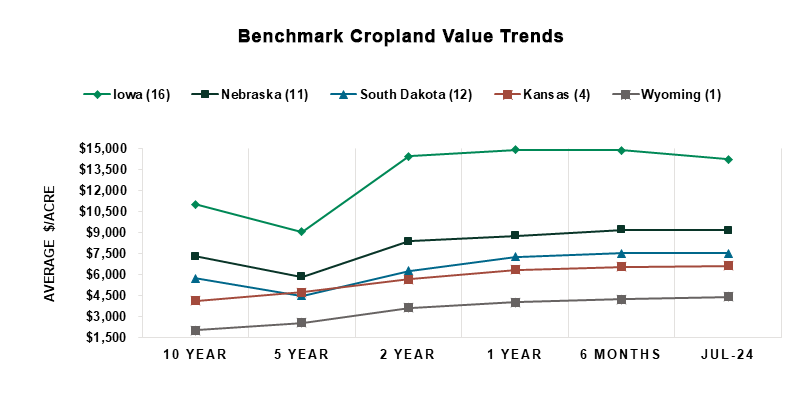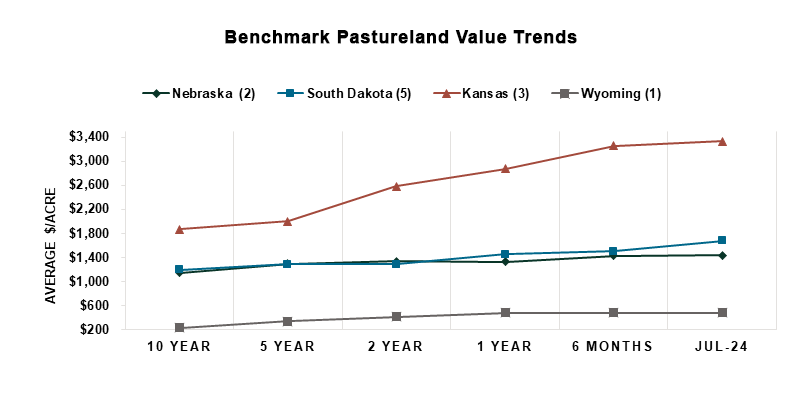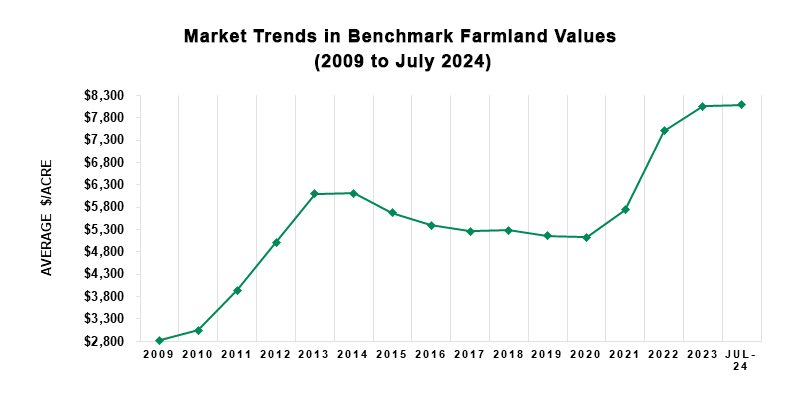While still at or near record levels, farmland values have stabilized in Iowa, Kansas, Nebraska, South Dakota and Wyoming, the five states served by Farm Credit Services of America (FCSAmerica) and Frontier Farm Credit. As a whole, benchmark values ticked up an average of 0.07% in the first half of 2024, according to the Benchmark Farm Value Trends Report jointly issued by the two Associations.
Land values made modest gains in Nebraska, South Dakota, Wyoming and eastern Kansas. Each state experienced increases in cropland and pasture.


Iowa by comparison, saw values decline for the first time in five years. Iowa generally serves as a leading indicator for the real estate trends. The market there has been relatively stable to slightly decreasing since 2022. Despite the recent pullback, Iowa’s benchmark values are up nearly 60% since 2019.
“The combination of higher interest rates and tighter margins for grain producers is having an impact on cropland values,” said Tim Koch, executive vice president of business development for the two Associations, which operate as part of a collaboration.
The percentage changes below are based on puritan benchmark farms, or those that are either exclusively cropland or pasture. Of the 70 benchmark farms, 55 are puritan cropland or pasture. None of the Iowa benchmark farms are puritan pasture ground.
State | Six-Month Change | One-Year Change | Two-Year Change | Five-Year Change | Ten-Year Change |
|---|
Iowa (21) | -2.4% | -2.4% | 1.4% | 58.3% | 34% |
Kansas (7) | 2.2% | 9.6% | 21.4% | 51.7% | 74.9% |
Nebraska (18) | 0.2% | 4.7% | 13.5% | 49.9% | 25% |
South Dakota (22) | 3.6% | 6.3% | 21% | 53.3% | 35% |
Wyoming (2) | 2.7% | 5.1% | 19% | 57.8% | 112.7% |
Market Forces Shaping Farmland Values
Some of the factors that supported a strong real estate market in recent years are still in play. This includes financially strong buyers and a limited supply of ground.
Cropland sales reported in the first half of 2024 were off as much as 80% in areas compared to the same period in 2023. In South Dakota and eastern Kansas, however, public auctions were up.
The buyers in the market are unchanged – primarily agricultural producers with cash from back-to-back years of record farm profits or debt locked in when interest rates were near historical lows. However, Koch said, there likely are fewer buyers as a result of tighter margins. Investors also have left for higher returns.
Profitability created optimism in the market and helped to offset the impact of the Federal Reserve’s rate hikes in late 2022 into 2023. Declining grain prices have shifted attention to the need to preserve working capital and managing costs, Koch said.

State-by-State Farmland Trends
Iowa: Benchmark values for cropland have shown an average decline of -3.6% for both the past six and 12 months.
Public auctions in the first half of 2024 were down 24% compared to the previous year. Total cropland sales were down 28% compared to the second quarter of 2023.
The average sale price for unimproved cropland in the second quarter of 2024 was $12,784 per acre.
Kansas: Cropland values in the eastern part of Kansas served by Frontier Farm Credit rose an average of 1.9% and 5.8% during the past six and 12 months, respectively, pointing to stable values.
Pasture values, supported by profitability in the cow-calf sector, are up an average of 2.7% and 14.8% for the same time periods. The demand for pasture remains strong and Flint Hills pasture continues to show a steady increase.
Public auctions increased 24% compared to the same period in 2023. Very few sales of highly tillable farms were reported in the second quarter of 2024. Those that have been recorded had an average per-acre price of $4,469, about 21% lower than in the first quarter of 2024.
Nebraska: Cropland values increased an average of 0.5% in the past six and 4.8% in the past 12 months. The market is relatively stable, with continued strength for top quality cropland.
Pasture benchmark values increased an average of 0.4% and 6.5% in the past six and 12 months, respectively.
Public land auctions in the first six months were down 13% compared to the same period a year ago. Total dryland cropland declined nearly 70% from the first to second quarter of 2024, with an average per-acre price of $6,134 in the second quarter. Sales of irrigated land dropped nearly 60% during the same period, with an average second-quarter price of $7,830 per acre.
South Dakota: Benchmark cropland values improved an average of 1.1% and 4.5% for the past six and 12 months.
Pasture benchmark values increased an average of 10.4% and 14.7% for the same periods.
Public land auctions rose 19% in the first half of 2024 compared to the same period in 2023. The average second-quarter price for unimproved cropland was $6,751.
Wyoming: Cropland values increased 4.4% and 9.2% during the past six and 12 months.
Pastureland is up 1.0% and 2.5% for the same time periods.
Sales reported in the second quarter of 2024 average $2,130 per acre.

